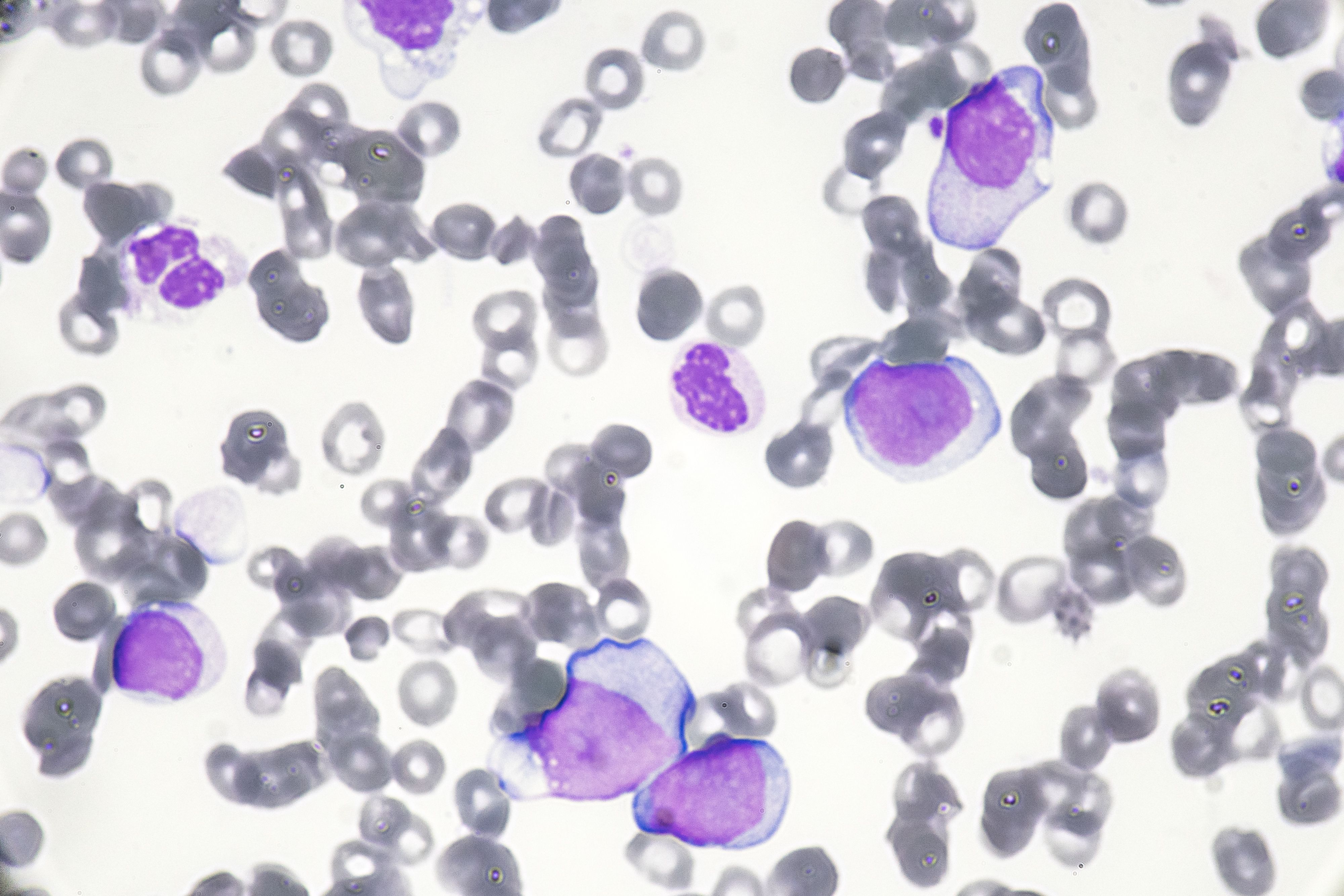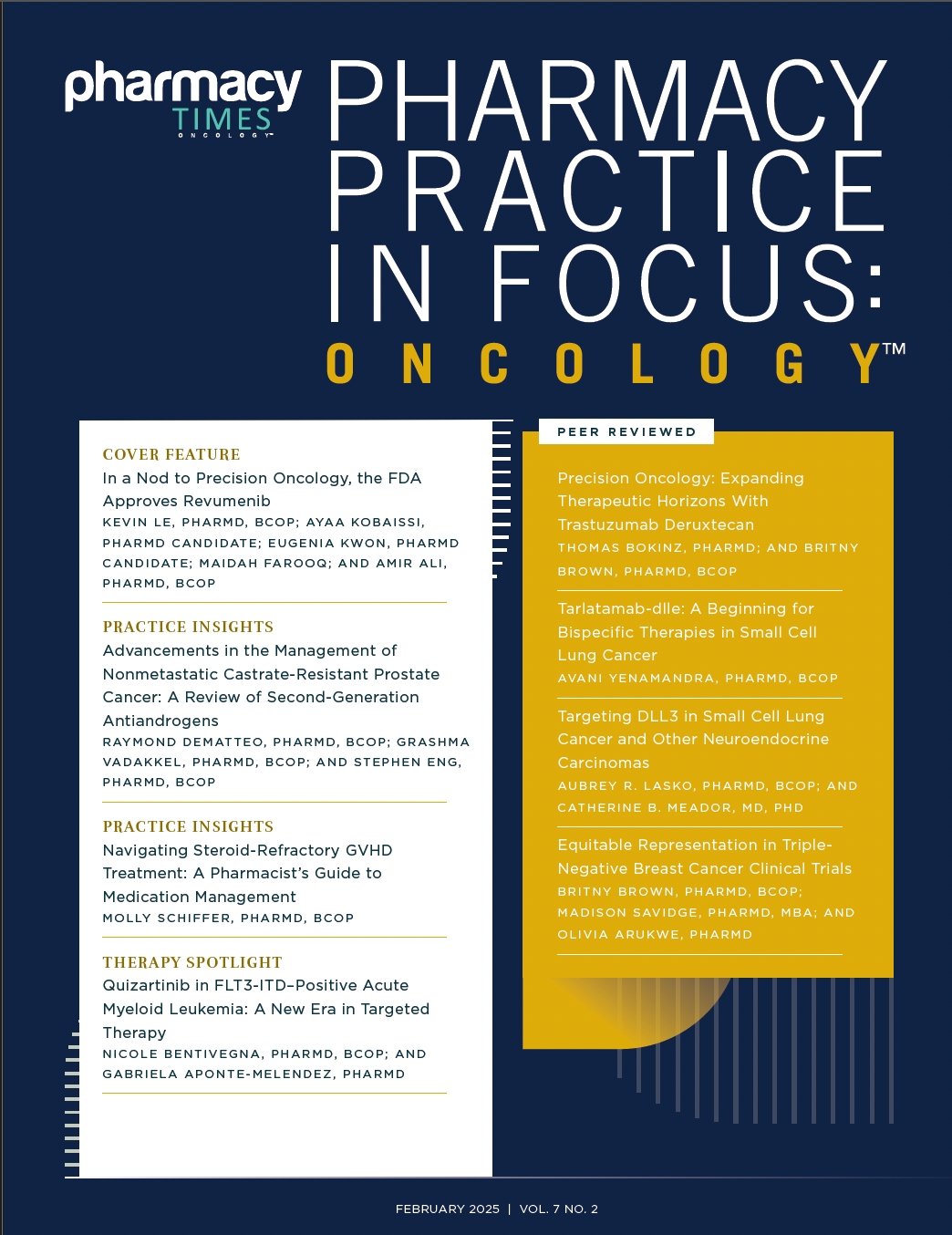FLT3 mutations are present in approximately 25% to 30% of acute myeloid leukemia (AML) cases, leading to aggressive disease and poor outcomes.1 FLT3 inhibitors encompass a diverse group of agents that target mutations in the FLT3 gene, which are implicated in the development of AML (Online Table).
First-generation inhibitors, such as sorafenib (Nexavar; Bayer HealthCare Pharmaceuticals Inc) and lestaurtinib (CEP-701; Teva Pharmaceuticals and Tocris Bioscience), were initially utilized in other cancers but showed limited efficacy in AML.2 Midostaurin (Rydapt; Novartis Pharmaceuticals Corporation), another first-generation FLT3 inhibitor, is approved in combination with chemotherapy during induction and consolidation phases in patients with newly diagnosed FLT3-mutated AML, showing improved overall survival (OS) compared with standard treatment.3 Second-generation inhibitors, such as gilteritinib (Xospata; Astellas Pharma US, Inc) and crenolanib (ARO-002; Arog Pharmaceuticals and Pfizer), offer greater selectivity and potency.3 Gilteritinib, a more selective FLT3 inhibitor, is approved for use in relapsed or refractory (R/R) AML with FLT3 mutations and has demonstrated superior response rates to salvage chemotherapy.4 Crenolanib, still under investigation, holds promise due to its ability to inhibit both FLT3 internal tandem duplication (ITD) and FLT3 tyrosine kinase domain (TKD) mutations, providing a broader therapeutic scope.5 These agents play a crucial role in addressing FLT3-driven leukemogenesis and enhancing treatment outcomes for a high-risk group of patients with AML.
Quizartinib (Vanflyta; Daiichi Sankyo, Inc) is a new, potent tyrosine kinase inhibitor designed to target AML with FLT3-ITD mutations. Approved by the FDA in 2023, quizartinib represents a significant advancement in the treatment of FLT3-mutated AML, providing a new additional treatment option.6 As a selective inhibitor of the FLT3 receptor tyrosine kinase, quizartinib plays a critical role in disrupting the signaling pathways responsible for hematopoietic cell differentiation and proliferation.7 Quizartinib works by inhibiting FLT3 signaling, thereby reducing the proliferation and survival of leukemic blasts with FLT3-ITD mutations. This inhibition promotes apoptosis, which helps reduce disease burden. Its selectivity for FLT3 allows it to minimize off-target effects, making it an important option in the management of FLT3-mutated AML.7
QuANTUM-First Study
The QuANTUM-First trial (NCT02668653) was a randomized, double-blind, placebo-controlled phase 3 study that established quizartinib’s efficacy in combination with standard chemotherapy in newly diagnosed patients with FLT3-ITD–positive AML. The study included 539 patients who were randomly assigned to receive either quizartinib or placebo along with standard induction chemotherapy (cytarabine and anthracycline).8
The trial demonstrated a significant improvement in median OS in the quizartinib group of 31.9 months compared with 15.1 months in the placebo group.8 The improvement in survival emphasized quizartinib’s role in reducing the risk of relapse and prolonging life in patients with FLT3-ITD–positive AML. In addition, event-free survival also showed meaningful improvement, highlighting quizartinib’s ability to enhance remission rates and delay disease progression.
Dosing and Administration
Quizartinib is available as 17.7-mg and 26.5-mg oral tablets.6 The dosing is as follows:
- Induction therapy: 35.4 mg orally once daily on days 8 to 21 of “7 + 3” (cytarabine [100 or 200 mg/m2/d] on days 1 to 7 plus daunorubicin [60 mg/m2/d] or idarubicin [12 mg/m2/d] on days 1-3) and on days 8 to 21 or 6 to 19 of an optional second induction (“7+3” or “5+2” [5 days cytarabine plus 2 days daunorubicin or idarubicin]
- Consolidation therapy: 35.4 mg orally once daily on days 6 to 19 of high-dose cytarabine (1.5 to 3 g/m2 every 12 hours on days 1, 3, and 5) for up to 4 cycles
- Maintenance therapy: 26.5 mg orally once daily on days 1 to 14, followed by 53 mg once daily, thereafter, for up to thirty-six 28-day cycles
Quizartinib is typically used in combination with a standard chemotherapy regimen during induction and consolidation, and as monotherapy during the maintenance phase following induction chemotherapy. Quizartinib can be taken with or without food at approximately the same time each day.6
Adverse Effects and Monitoring
Like other tyrosine kinase inhibitors, quizartinib is associated with a variety of adverse effects (AEs). Common hematologic toxicities include neutropenia, anemia, and thrombocytopenia. Other frequently reported AEs include peripheral edema, fatigue, fever, nausea, vomiting, and diarrhea.9
Quizartinib is known to cause QT prolongation, which can lead to serious cardiac events such as ventricular arrhythmias and torsades de pointes.6 Due to the potential for QT prolongation, it is critical for patients receiving quizartinib to undergo electrocardiogram (ECG) monitoring and serum electrolytes assessments, including potassium, magnesium, and calcium levels, before starting this medication. Strong CYP3A inhibitors, as well as other QT-prolonging drugs, should be avoided during therapy, as they can also potentiate the risk for QT prolongation.9
QT interval monitoring should be conducted frequently, with ECGs recommended at baseline, weekly during induction and consolidation therapy, weekly for at least the first month of maintenance, and periodically thereafter.6 If the corrected QT interval using the Fridericia formula (QTcF) exceeds 450 milliseconds, quizartinib should not be initiated. For a QTcF of 480 milliseconds or higher, the dose should be interrupted until the QTcF returns to below 450 milliseconds. If QTcF exceeds 500 milliseconds at any point, quizartinib should be permanently discontinued due to the high risk of severe arrythmias.6 Additionally, electrolyte imbalances should be corrected, and the patient should be closely monitored for any signs of cardiac instability throughout the course of treatment.
REMS Program
The Risk Evaluation and Mitigation Strategy (REMS) program for quizartinib, known as Vanflyta REMS, was established to address the serious risk of QT prolongation and the potential for fatal arrythmias such as torsades de pointes.10 Under this program, health care providers and institutions must comply with specific requirements before prescribing and dispensing quizartinib. Prescribers must be certified by enrolling in the REMS program, which involves completing training in the risks associated with quizartinib, particularly its QT prolongation risk, and how to appropriately monitor patients. Similarly, pharmacies must be certified to dispense quizartinib by enrolling in the REMS program, which ensures they are aware of the medication’s risks and the need for regular ECG monitoring and electrolyte management.10
Patients must receive counseling on the risk of QT prolongation, including the importance of attending scheduled ECG appointments and adhering to electrolyte monitoring. The REMS program also requires that patients are provided with a medication guide, outlining the risk of QT prolongation and signs of arrythmias they should monitor for, such as dizziness or palpitations. Regular reporting and documentation of QTcF intervals are required, and any instances of QTcF prolongation beyond the safety thresholds must be addressed per the REMS guidelines, including dose modifications or discontinuation, if necessary.10
Place in NCCN Guidelines
According to the National Comprehensive Cancer Network (NCCN) guidelines for AML, quizartinib is recommended as a standard treatment option for patients with newly diagnosed FLT3-ITD–positive AML, in combination with chemotherapy. Quizartinib is classified as a category 1 recommendation for these patients in the context of induction therapy, underscoring its strong evidence of efficacy based on randomized clinical trials. It is also recommended for use during consolidation therapy following induction and consolidation phases.11
About the Authors
Nicole Bentivegna, PharmD, BCOP, is a clinical pharmacy services manager and NCODA medically-integrated oncology pharmacy residency program director at Florida Cancer Specialists & Research Institute and Rx To Go, LLC, in Fort Myers, Florida.
Gabriela Aponte-Melendez, PharmD, is a clinical staff pharmacy resident at Florida Cancer Specialists & Research Institute in Fort Myers, Florida.
Compared with other FLT3 inhibitors, quizartinib has demonstrated significant efficacy, particularly for FLT3-ITD mutations, and its approval provides an alternative to drugs such as midostaurin and gilteritinib. Although midostaurin is also recommended in the first-line setting for FLT3-mutated AML, its role primarily focuses on broader FLT3 mutations, including both ITD and TKD types. Quizartinib, on the other hand, has more selectivity for FLT3-ITD and has shown superior potency in this subgroup. Additionally, gilteritinib, which is recommended primarily for R/R FLT3-mutated AML, offers another therapeutic option but is generally used after the failure of first-line therapies. The incorporation of quizartinib into the NCCN guidelines reflects its pivotal role in improving survival outcomes for FLT3-ITD–positive patients and solidifies its place among FLT3-targeted therapies as a first-line treatment option in AML.
REFERENCES
Daver N, Schlenk RF, Russell NH, Levis MJ. Targeting FLT3 mutations in AML: review of current knowledge and evidence. Leukemia. 2019;33(2):299-312. doi:10.1038/s41375-018-0357-9
Metzelder SK, Schroeder T, Finck A, et al. High activity of sorafenib in FLT3-ITD-positive acute myeloid leukemia synergizes with allo-immune effects to induce sustained responses. Leukemia. 2012;26(11):2353-2359. doi:10.1038/leu.2012.105
Stone RM, Mandrekar SJ, Sanford BL, et al. Midostaurin plus chemotherapy for acute myeloid leukemia with a FLT3 mutation. N Engl J Med. 2017;377(5):454-464. doi:10.1056/nejmoa1614359
McMahon CM, Perl AE. Gilteritinib for the treatment of relapsed and/or refractory FLT3-mutated acute myeloid leukemia. Expert Rev Clin Pharmacol. 2019;12(9):841-849. doi:10.1080/17512433.2019.1657009
Wang ES, Goldberg AD, Tallman M, et al. Crenolanib and intensive chemotherapy in adults with newly diagnosed FLT3-mutated AML. J Clin Oncol. 2024;42(15):1776-1787. doi:10.1200/jco.23.01061
Kiyoi H, Kawashima N, Ishikawa Y. FLT3 mutations in acute myeloid leukemia: therapeutic paradigm beyond inhibitor development. Cancer Sci. 2020;111(2):312-322. doi:10.1111/cas.14274
Erba HP, Montesinos P, Kim HJ, et al; QuANTUM-First Study Group. Quizartinib plus chemotherapy in newly diagnosed patients with FLT3-internal-tandem-duplication-positive acute myeloid leukaemia (QuANTUM-First): a randomised, double-blind, placebo-controlled, phase 3 trial. Lancet. 2023;401(10388):1571-1583. doi:10.1016/s0140-6736(23)00464-6
Kang D, Ludwig E, Jaworowicz D, et al. Concentration–QTc analysis of quizartinib in patients with relapsed/refractory acute myeloid leukemia. Cancer Chemother Pharmacol. 2021;87(4):513-523. doi:10.1007/s00280-020-04204-y
VANFLYTA Risk Evaluation and Mitigation Strategy (REMS). Vanflytarems.com. AccessedJanuary 14, 2025. https://www.vanflytarems.com/#Main
NCCN. Clinical Practice Guidelines in Oncology. Acute myeloid leukemia, version 1.2025. Accessed January 14, 2025. https://www.nccn.org/professionals/physician_gls/pdf/aml.pdf









